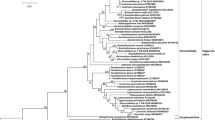Abstract
Pooled tissue samples are frequently used in biochemical studies involving parasites in order to ensure that there is sufficient material for experimentation. A pooled sample is considered to represent the overall phenotypic characteristics of the investigated population. However, this will not be the case if there is a significant degree of molecular polymorphism among individuals in the sampled population. Here we demonstrate marked differences in the protein profile of salivary glands among individuals from three species of ixodid tick (Rhipicephalus appendiculatus, Amblyomma variegatum, Ixodes ricinus), and show that pooling the tissue of several individuals masks substantial qualitative differences among the individuals. Our observations indicate that much greater caution is needed in general when using pooled samples if the molecular diversity within the population is not clearly defined.
Similar content being viewed by others
References
Bull, C.M., Andrews, R.H. and Adams, M. 1984. Patterns of genetic variation in a group of parasites, the Australian reptile ticks. Heredity 53: 509-526.
Davey, R.B. and Hilburn, L.R. 1991. Reduction in egg viability resulting from infestations on cattle of hybridized Boophilus ticks and B. microplus (Acari: Ixodidae) at various ratios. J. Med. Entomol. 28: 763-769.
Feldman Muhsam, B., Borut, S. and Saliternik Givant, S. 1970. Salivary secretion of the male tick during copulation. J. Insect. Physiol. 16: 1945-1949.
Fritz, G.N., Conn, J., Cockburn, A. and Seawright, J. 1994. Sequence analysis of the ribosomal DNA internal transcribed spacer 2 from populations of Anopheles nuneztovari (Diptera: Culicidae). Mol. Biol. Evol. 11: 406-416.
Gomes, A.F. and Wouters, G. 1991. Species identification of Rhipicephalus duttoni in relation to the Rhipicephalus appendiculatus group (Acarina: Ixodidae). J. Med. Entomol. 28: 16-18.
Harris, E.L.V. and Angal, S. 1989. Protein purification methods. 1. Protein purification. IRL Press, Oxford.
Healy, J.A. 1979. Phosphoglucomutase polymorphism in the tick Ixodes ricinus. Parasitology 78: 7-17.
Hilburn, L.R. and Sattler, P.W. 1986. Electrophoretically detectable protein variation in natural populations of the lone star tick, Amblyomma americanum (Acari: Ixodidae). Heredity Edinburgh 57: 67-74.
Jones, L.D., Davies, C.R., Steele, G.M. and Nuttall, P.A. 1987. A novel mode of arbovirus transmission involving a nonviremic host. Science 237: 775-777.
Moorhouse, D.E. and Tatchell, R.J. 1966. The feeding processes of the cattle-tick Boophilus microplus (Canestrini): a study in host-parasitic relations. I. Attachment to the host. Parasitology 56: 623-632.
Needham, G.R. and Teel, P.D. 1991. Off-host physiological ecology of ixodid ticks. Annu. Rev. Entomol. 36: 659-681.
Nuttall, P.A. 1998. Displaced tick-parasite interactions at the host interface. Parasitology 116: S65-S72.
Nuttall, P.A., Jones, L.D., Labuda, M. and Kaufman, W.R. 1994. Adaptations of arboviruses to ticks. J. Med. Entomol. 31: 1-9.
Ribeiro, J.M. 1989. Role of saliva in tick/host interactions. Exp. Appl. Acarol. 7: 15-20.
Rich, S.M., Rosenthal, B.M., Telford, S.R. 3rd, Spielman, A., Hartl, D.L. and Ayala, F.J. 1997. Heterogeneity of the internal transcribed spacer (ITS-2) region within individual deer ticks. Insect Mol. Biol. 6: 123-129.
Rudolph, D. and Knulle, W. 1974. Site and mechanism of water vapour uptake from the atmosphere in ixodid ticks. Nature 249: 84-85.
Sauer, J.R., McSwain, J.L., Bowman, A.S. and Essenberg, R.C. 1995. Tick salivary gland physiology. Annu. Rev. Entomol. 40: 245-267.
Sonenshine, D.E. 1991. Biology of ticks (I). Oxford University Press, New York and Oxford.
Sonenshine, D.E. 1993. Biology of ticks (II). Oxford University Press, New York and Oxford.
Wang, H., Paesen, G.C., Nuttall, P.A. and Barbour, A.G. 1998. Male ticks help their mates to feed. Nature 391: 753-754.
Wesson, D.M., McLain, D.K., Oliver, J.H., Piesman, J. and Collins, F.H. 1993. Investigation of the validity of species status of Ixodes dammini (Acari: Ixodidae) using rDNA. Proc. Natl. Acad. Sci. USA 90: 10221-10225.
Wesson, D.M., Porter, C.H. and Collins, F.H. 1992. Sequence and secondary structure comparisons of ITS rDNA in mosquitoes (Diptera: Culicidae). Mol. Phylogenet. Evol. 1: 253-269.
Wikel, S.K. 1996. Host immunity to ticks. Annu. Rev. Entomol. 41: 1-22.
Author information
Authors and Affiliations
Rights and permissions
About this article
Cite this article
Wang, H., Kaufman, W. & Nuttall, P. Molecular individuality: polymorphism of salivary gland proteins in three species of ixodid tick. Exp Appl Acarol 23, 969–975 (1999). https://doi.org/10.1023/A:1006362929841
Issue Date:
DOI: https://doi.org/10.1023/A:1006362929841




